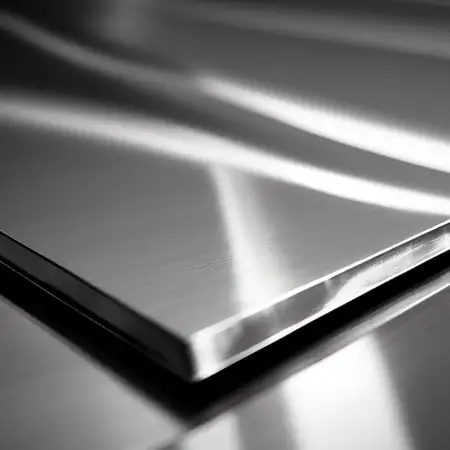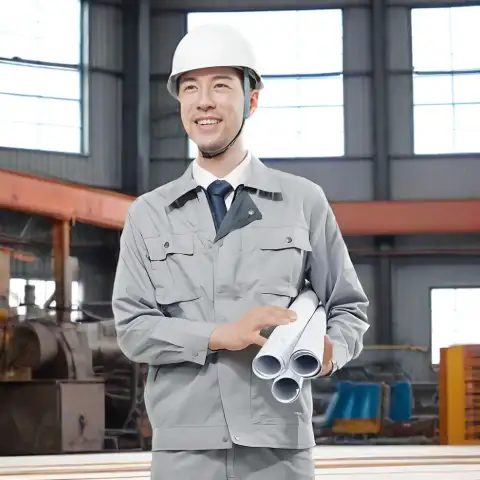For most exterior architectural and light-industrial uses where budget, color options and fast lead times matter, high-quality powder-coated carbon steel with proper surface pretreatment and system selection delivers excellent life-cycle performance and lower upfront cost. For corrosive, sanitary, high-temperature, or contact-sensitive environments (marine, food, medical, chemical processing, or where long maintenance-free life is required), stainless steel (selected grade) is the safer, longer-term choice because its corrosion resistance is inherent to the alloy rather than dependent on a coating. The correct selection depends on environment, required service life, maintenance capability, mechanical demands, and total cost of ownership.
Powder Coated Steel vs Stainless Steel Comparison
| Attribute | Powder-coated carbon steel (typical) | Stainless steel (common grades 304 / 316) |
|---|---|---|
| Upfront cost | Low — material + coating | High — alloy cost |
| Appearance options | Unlimited colors/finishes | Metallic luster; limited surface finishes |
| Corrosion resistance | Very good if coating intact & proper pretreatment | Excellent — passive film on alloy |
| Edge & cut resistance | Vulnerable to undercut corrosion where coating is breached | Inherent resistance — less sensitive to scratches |
| Mechanical toughness | Base metal properties (can be high) | Often higher toughness in duplex/316 types |
| Maintenance | Recoating required after damage | Low — usually cleaning/passivation only |
| Service life (outdoor) | 10–25+ years depending on system and environment | 25+ years in many environments |
| Repairability | Relatively easy: spot repair or recoat | More difficult: grinding/welding + passivation |
| Standards / testing | ISO 12944 guidance, ASTM B117 testing used for coatings | Metallurgical standards (EN, ASTM), corrosion data |
| Best use | Painted architectural elements, fences, HVAC, furniture | Food contact, marine, medical, chemical plant |
What powder coating is and how it protects steel
Powder coating is a dry finishing method where charged polymer powder is applied electrostatically and then cured to form a continuous film. Modern powder systems (polyester, epoxy, epoxy-polyester hybrids, polyurethane) provide a hard, resilient film that resists abrasion, fading and common household chemicals. Proper pretreatment (degrease, abrasive blast, conversion coating such as phosphating or chromating, or chrome-free alternatives) and controlled film thickness are essential to achieving long service life. Quality powder systems are widely used because they combine durability, visual options and environmental advantages compared with liquid paints.
Key technical notes for procurement:
-
Pretreatment is as important as the powder chemistry. Ask for phosphating or validated chrome-free conversion chemistry compatible with the chosen powder.
-
Film thickness and edge coverage are critical: edge crevices are typical failure initiation points.
-
Specify acceptable scribe/creep limits and test hours when buying to match the site exposure (see section on standards).

Why stainless steel resists corrosion
Stainless steel achieves corrosion resistance primarily through a chromium-rich passive oxide film that forms spontaneously on the surface when the alloy contains roughly ≥10.5% chromium. Alloy additions such as nickel, molybdenum and nitrogen further improve resistance in aggressive media (for example 316 contains molybdenum to resist chloride attack). Because resistance is intrinsic to the metal, scratches or small mechanical damage do not typically lead to rust in the same way a breached paint system does. For highly aggressive chloride environments or very long life requirements, duplex or super-austenitic grades are specified.
Mechanical performance, abrasion and impact
Powder coatings form a durable outer surface that is often harder than liquid paint and resists chipping and abrasion. However, the coating is still a different material to the substrate and will behave differently under impact. Stainless steel’s ductility and yield strength depend on grade — many stainless alloys (especially duplex grades) offer high strength and good toughness. When a project combines heavy wear and heavy structural loading, specify both substrate grade and coating system together and require mechanical testing (for e.g., mandrel bend, impact tests).
Practical rule:
-
For heavy sliding wear (metal-to-metal contact), stainless steel surfaces or engineered wear liners outperform coated carbon steel.
-
For decorative use with only occasional knocks, powder coat gives excellent perceived durability at lower cost.
Edge-effects, scribe testing and how failures start
Coatings can protect bulk surfaces very well, but edges, welds, drilled holes and cut ends are where moisture, salt and chemicals can breach protection. Two common failure modes:
-
Underfilm corrosion (creep/undercutting) — corrosion progresses at the coating-metal interface from a breach or scribe.
-
Galvanic attack at dissimilar metal junctions — stainless in contact with coated carbon steel can promote local corrosion if the coating fails and electrical continuity exists.
When specifying coated steel for demanding locations, call out edge treatment (edge sealer, pre-zinc, or edge-fill systems), and require scribe testing and salt spray performance tied to ISO 12944 corrosivity categories.

Environments and how they change the answer
Break environments into categories:
-
Mild indoor (office, retail): powder coating is cost-efficient and visually flexible.
-
Outdoor urban (rain, pollution): high-quality powder on pretreated steel can deliver many years; choose systems rated to ISO 12944 C3–C4.
-
Coastal/marine (salt spray, high chloride): stainless (316 or duplex) is usually preferred; otherwise use heavy-duty zinc primer + epoxy + polyester powder meeting C5-M or C5-H systems.
-
Chemical exposure: pick alloy or coating chemistries with proven resistance; some chemicals attack polymers used in powders.
-
Food/medical: stainless is typically mandatory for hygiene and cleanability.
ISO 12944 provides a framework that ties exposure categories to minimum coating systems and expected durability; use it when defining procurement specs.
Standards and test methods to specify (what to put in the purchase order)
Practical standards to cite in specs:
-
ISO 12944 — corrosion categories and system selection for protective organic coatings (useful when specifying powder systems and required durability).
-
ASTM B117 / ISO 9227 — neutral salt spray (fog) testing for relative assessment of coating resistance; useful for comparative evaluation but not an absolute life-prediction. Require scribe and cyclic testing if real-world simulation is needed.
-
Pretreatment standard and technical datasheets — ask the coating supplier for their product data sheet (PDS) and performance in salt spray, humidity, and adhesion tests.
-
Stainless steel material standards — specify EN/ASTM material grades (e.g., EN 1.4301 / ASTM A240 for 304; EN 1.4404 / ASTM A240 for 316) and surface finish (2B, BA, No.4 brushed, etc.).
-
Galvanic corrosion guidance — use AMPP / NACE literature for joint design and insulating methods when mixing metals.
Important procurement tip: Don’t accept vague “salt spray 500 hours” without stating scribe, creep acceptance, and which standard or test lab is used. Include acceptance criteria and third-party test laboratory certificates when life-cycle is important.
Fabrication, welding, joining and galvanic issues
-
Welding stainless: heat tint and contamination can reduce local corrosion resistance unless post-weld cleaning / passivation is performed. Specify passivation and pickling procedures in the fabrication scope.
-
Welding coated steel: typically you weld first, then coat; welded areas require edge treatment and touch-up to maintain system integrity.
-
Fasteners: avoid using dissimilar metals across wet/abrasive service without insulating materials; stainless fasteners are the safest when used with stainless parts. If stainless and coated carbon steel must be combined, design for electrical isolation or a protective overlapping coating zone.
Cost modelling and total cost of ownership (TCO)
Upfront cost is only one factor. Consider:
-
Initial purchase price: powder-coated carbon steel often 30–70% cheaper up front than stainless, depending on grade and thickness.
-
Maintenance frequency: coatings need inspection and occasional local repairs; stainless generally requires less intervention.
-
Replacement risk: in extreme environments, coating failure can lead to structural deterioration earlier than stainless, increasing long-term replacement cost.
-
Aesthetic lifetime: if color consistency or precise brand color is needed for many years, high-quality coating systems are easier to match and recolor than trying to paint stainless repeatedly.
Create a simple discounted cash flow for expected inspection, maintenance and replacement cycles to compare real TCO rather than sticker price.
Why choose MWAlloys
MWAlloys is a specialized metal materials supplier focusing on stainless and coated steel components for global industrial and architectural projects. We provide:
-
Factory direct pricing from our Chinese production partners — competitive, 100% factory outlet pricing for volume orders.
-
Fast stock delivery on common items (sheet, plate, standard fabrications) and rapid production slots for custom orders.
-
Technical backup — material certificates, coating PDS, third-party testing on request.
-
Custom finishing — we can supply pretreated and powder-coated assemblies with specified ISO 12944 systems or supply certified stainless steel with passivation and finish.
Detailed comparison table
| Factor | Specification to demand for powder coat | Specification to demand for stainless |
|---|---|---|
| Pretreatment | Abrasive blast Sa2.5 or phosphate + conversion chemistry; PDS attached | Mill certificate, surface finish (2B, No.4), passivation spec |
| Coating system | Primer + top coat, total DFT (e.g., 80–120 μm), film build, edge coverage | N/A |
| Testing | ASTM B117 salt spray + EN ISO cyclic with scribe; adhesion pull/mandrel | Corrosion testing for grade in chloride solution, pitting resistance (PREN) |
| Edges/welds | Edge sealer or touch-up, specify acceptable scribe creep mm after 1000/2000h | Welding procedure spec + post-weld passivation |
| Fasteners | Same metal as substrate or insulating gasket | Stainless fasteners or alloy-matched |
FAQs
-
Is powder-coated steel the same as painted steel?
No, powder coating is a dry, electrostatically applied polymer that cures to form a tougher film than conventional liquid paint; however, both are organic coatings and can fail if breached. -
Can powder coating be used on stainless steel?
Yes, stainless can be powder coated for color or appearance, but unnecessary for corrosion protection; surface preparation and adhesion promotion are required. -
Which grade of stainless is better for coastal use: 304 or 316?
316 (with molybdenum) offers superior resistance to chlorides and is preferred for coastal and marine environments. -
How long does powder coating last outdoors?
With correct system selection and pretreatment, expect 10–25+ years depending on environment; specify ISO 12944 corrosivity rating when purchasing. -
Is salt spray testing a reliable predictor of field life?
Salt spray (ASTM B117 / ISO 9227) gives comparative data but does not perfectly predict real-world longevity — cyclic and field tests offer better correlation for many applications. -
Can powder coating be repaired on site?
Yes, small local repairs and touch-ups are routine, though matching texture and gloss requires skill and the original powder chemistry where possible. -
Are stainless bolts always necessary with stainless structures?
Prefer stainless fasteners to avoid dissimilar-metal corrosion; if mixed metals are unavoidable, electrically insulate the joint. -
What happens when a powder coating is scratched through to bare steel?
Corrosion can initiate at the exposed area and creep beneath the coating; rapid local repair and edge sealing are required to limit underfilm corrosion. -
Which has lower long-term maintenance: coated steel or stainless?
In harsh environments, stainless generally requires less maintenance. In moderate environments, a well-specified powder system can be lower cost over a planned maintenance interval. -
How should I write the specification if I want a 20-year life?
Use ISO 12944 to choose a coating system for the exposure category, require validated pretreatment, specific DFT, scribe/cyclic testing with pass/fail criteria, and warranty terms tied to inspection and maintenance schedule.

